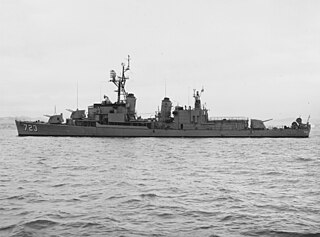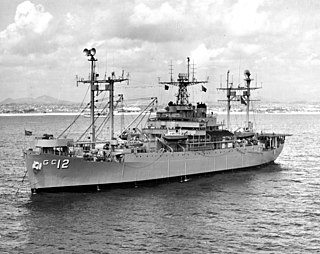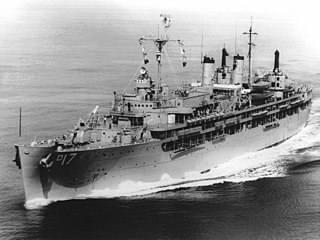
USS Topeka (CL-67), a Cleveland-class light cruiser in service with the United States Navy from 1944 to 1949. From 1957 to 1960, she was converted to a Providence-class guided missile cruiser and redesignated CLG-8. The cruiser served again from 1960 to 1969 and was finally scrapped in 1975.

USS Arnold J. Isbell (DD-869), a Gearing-class destroyer, was the only ship of the United States Navy to be named for Arnold J. Isbell, an aircraft carrier captain during World War II. The ship was laid down on 14 March 1945 at Staten Island, New York, by Bethlehem Mariners Harbor, launched on 6 August 1945 and commissioned on 5 January 1946. Constructed too late to see action in World War II, the vessel initially served as a training ship with the United States Atlantic Fleet, before transferring to the Pacific and deploying to Korea during the Korean War and off the Vietnam coast during the Vietnam War. In 1972 Arnold J. Isbell was made part of the reserve training fleet and in 1974, sold to Greece where the ship was renamed Satchouris and served with the Hellenic Navy until being sold for scrap in 2002.

USS Helena (CA-75), a Baltimore-class heavy cruiser, was the third ship of the United States Navy to be named for the city of Helena, Montana. Originally laid down as the USS Des Moines, she was renamed Helena while under construction after the 5 October 1944 cancellation of the Fargo-class light cruiser USS Helena (CL-113).

USS Oklahoma City (CL-91/CLG-5/CG-5) was one of 27 United States Navy Cleveland-class light cruisers completed during or shortly after World War II, and one of six to be converted to guided missile cruisers. She was the first US Navy ship to be named for Oklahoma City, Oklahoma. Commissioned in late 1944, she participated in the latter part of the Pacific War in anti-aircraft screening and shore bombardment roles, for which she earned two battle stars. She then served a brief stint with the occupation force. Like all but one of her sister ships, she was retired in the post-war defense cutbacks, becoming part of the Pacific Reserve Fleet in 1947.

USS Bryce Canyon (AD-36) was a Shenandoah-class destroyer tender, the only ship to be named for the Bryce Canyon National Park in Utah.

USS Coontz (DLG-9/DDG-40) was a Farragut-class destroyer leader/frigate in the United States Navy. She was named after Admiral Robert Coontz, the US Navy's second chief of naval operations.

USS Walke (DD-723), an Allen M. Sumner-class destroyer, was the third ship of the United States Navy to be named for Henry A. Walke, a Rear Admiral during the Mexican–American War and the American Civil War. The third Walke (DD-723) was laid down on 7 June 1943 at Bath, Maine, by the Bath Iron Works and launched on 27 October 1943; sponsored by Mrs. Douglas Dillon. The ship was commissioned at the Boston Navy Yard on 21 January 1944.

USS Blue (DD-744), an Allen M. Sumner-class destroyer, was the second United States Navy ship of that name, for Lieutenant Commander John S. Blue (1902–1942).

USS Alfred A. Cunningham (DD-752), an Allen M. Sumner-class destroyer, is the only ship of the United States Navy to be named for Alfred Austell Cunningham, a USMC officer and aviator.

USS Holland (AS-3) was a submarine tender that served in the United States Navy before and during World War II. Holland was launched by the Puget Sound Naval Shipyard, Bremerton, Washington on 12 April 1926, sponsored by Miss Elizabeth Saunders Chase, daughter of Admiral J. V. Chase, and commissioned on 1 June. Stationed at San Diego, California, tending submarine divisions there with periodic tours to Panama to service submarines based at the Canal Zone pre-World War two. Later serving in the Pacific theatre, by close of hostilities having given 55 instances of refit to submarines, provided repair and service to 20 surface craft and completed various jobs on shore installations.

USS Estes (AGC-12) was a Mount McKinley-class amphibious force command ship. It is officially named after "A mountain peak and national park in Colorado."

USS Bauer (DE-1025) was a Dealey-class destroyer escort in the United States Navy. She was named for Lieutenant Colonel Harold William Bauer, naval aviator and recipient of the Medal of Honor for extraordinary heroism and conspicuous courage as Commander of Marine Fighting Squadron 212 in the South Pacific between 10 May and 14 November 1942.

USS Hollister (DD-788) was a Gearing-class destroyer of the United States Navy, named for the three Hollister brothers, who were killed in 1943 while serving in the Navy during World War II.

USS Dennis J. Buckley (DD/DDR-808) was a Gearing-class destroyer of the United States Navy.

USS Klondike (AD-22/AR-22) was a destroyer tender in service the United States Navy from 1945 to 1970. In 1960, she was redesignated as a repair ship. After spending another five years in reserve, she was sold for scrap in 1975.

USS Piedmont (AD–17) was a Dixie-class destroyer tender built during World War II for the United States Navy. Her task was to service destroyers in, or near, battle areas and to keep them fit for duty. She served in the Pacific Ocean during World War II, the Cold War, the Korean War, and the Vietnam War. For her work in battle areas, the ship was awarded four battle stars for her Korean War efforts and one for Vietnam War service.

USS Hector (AR-7) was a repair ship that served in the United States Navy from 1944 to 1987 and as PNS Moawin in the Pakistan Navy from 1989 to 1994.

USS Satyr (ARL-23) was one of 39 Achelous-class landing craft repair ships built for the United States Navy during World War II. Named for the Satyr, she was the only US Naval vessel to bear the name.

USS Sierra (AD-18) was a Dixie-class destroyer tender built just before the start of World War II for the U.S. Navy. Her task was to service destroyers in, or near, battle areas and to keep them fit for duty.

USS Yosemite (AD-19) was a Dixie-class destroyer tender built just before the start of World War II for the U.S. Navy. Her task was to service destroyers in, or near, battle areas and to keep them fit for duty.




















